[ Download Link ]
Mod author: Acifer
Version used for review: 1.1.
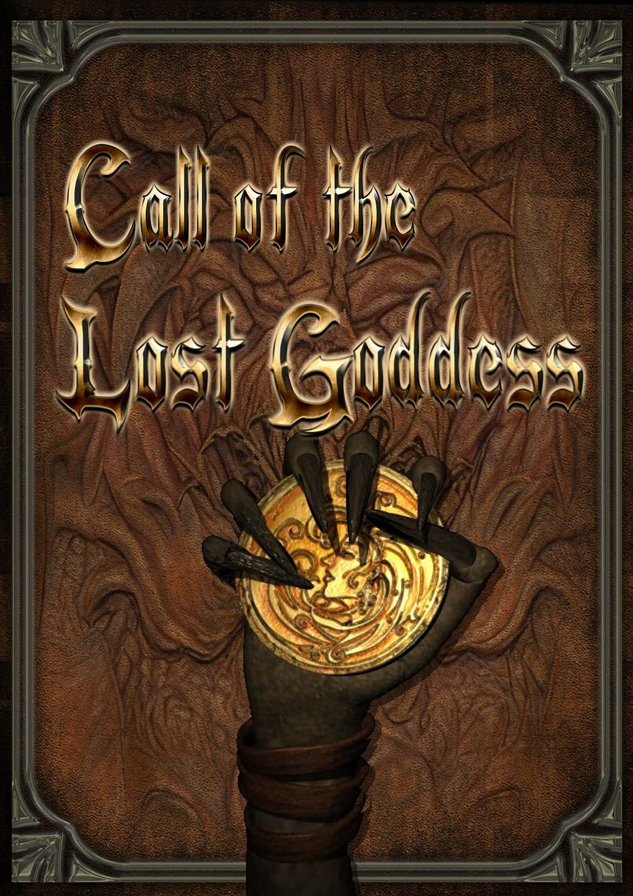
Call of the Lost Goddess – Trailer
“Waukeen …..dead? No, comrade. Although even gods could die, I would know it if the Merchant’s Friend had gone to the astral realm. The Golden Lady is only on a great caravan, and her coin will soon shine again. In the meantime, a regent watches over the counting house, giving us hope that the Lady of Coin will reward us for our trust in her and in her chosen regent.”
– Holycoin and Voice of the Lady Tharundar Olehm, Abbey of the Goldspires, Athkatla.
Throughout the Baldur’s Gate saga, we see many different planes of existence. One significant layer of the cosmos that we are never privy to, though, is the Abyss, birthplace of demons. Call of the Lost Goddess offers the opportunity to delve into this previously unexplored aspect of the cosmos in grand fashion, with one of the most thoughtful and finely crafted mods I’ve ever played.
During the Time of Troubles, Waukeen — the goddess of trade — disappeared. The truth of the matter was that she herself had ventured into the Abyss, having made a deal with the demon Graz’zt for safe passage through his realm back to the Outlands. The demon lord unsurprisingly went back on his word and decided to keep her prisoner.
By the time that the events of Baldur’s Gate II come around, Waukeen is still held captive by the demon lord. There exists a 2nd Edition tabletop adventure named For Duty and Deity that sees a group of adventurers rescuing Waukeen from her prison in the Abyss, and it is this module that this mod has been based upon — with great success.
Call of the Lost Goddess is a massive mod, introducing what truly feels like a classic expansion of the Shadows of Amn we know and love. It took me about 10 hours to complete, and I did so twice. The sheer sense of grand adventure that I felt embarking on this quest was very reminiscent of the first time I played Shadows of Amn. It shares an inherent piece of DNA with the game, coming from the same era of D&D, that really shines through in the execution.
Part of what makes Call of the Lost Goddess special to me is evident from the very moment that the quest is introduced. Despite the fact that the events of the quest will have you embark on what is likely the grandest adventure you have been on up to this point in the series, the initial quest-giver is naught but a messenger that stands outside the temple of Waukeen in the Government District. He tells you that the Church is seeking adventurers, and then leaves you alone. Only upon entering into the church and enquiring will you learn more, and then you’re one again directed to a higher-up member of the clergy.
I always find it incredibly distracting when there’s a side character ready to exposit an entire quest’s premise at the first opportunity. That’s not really engaging, nor is it the way that Baldur’s Gate typically handles side quests, whether they be big or small. Planting the seeds of adventure is something Baldur’s Gate II does exceptionally well — strange attacks in Trademeet, monsters bountied in Windspear Hills for a suspiciously large sum of gold, a mysterious cult recruiting folks in the street… the list goes on. These seeds open up so many avenues of adventure and it never truly feels like one is more important than the other. Call of the Lost Goddess simply adds one more seed to the pool.
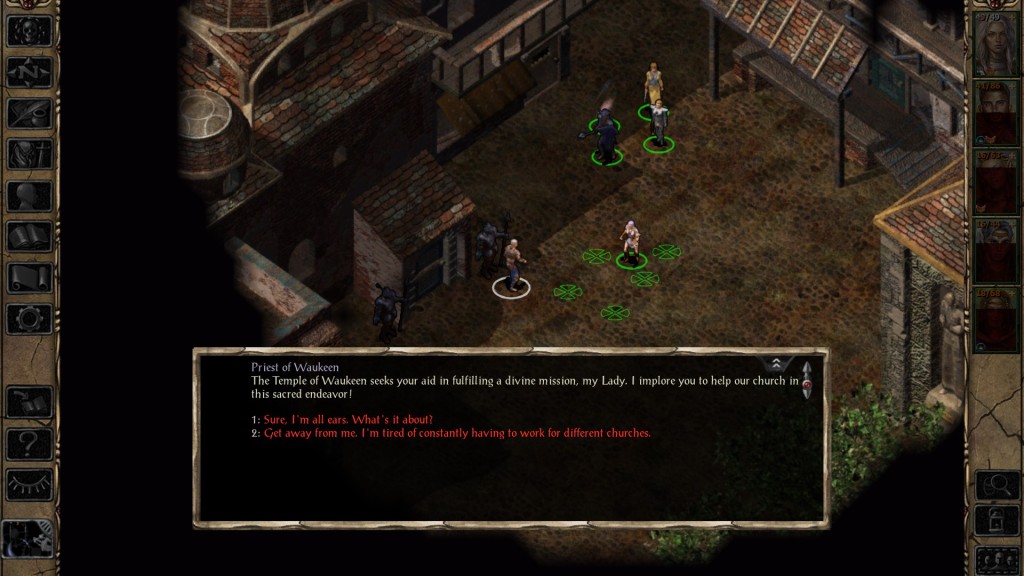
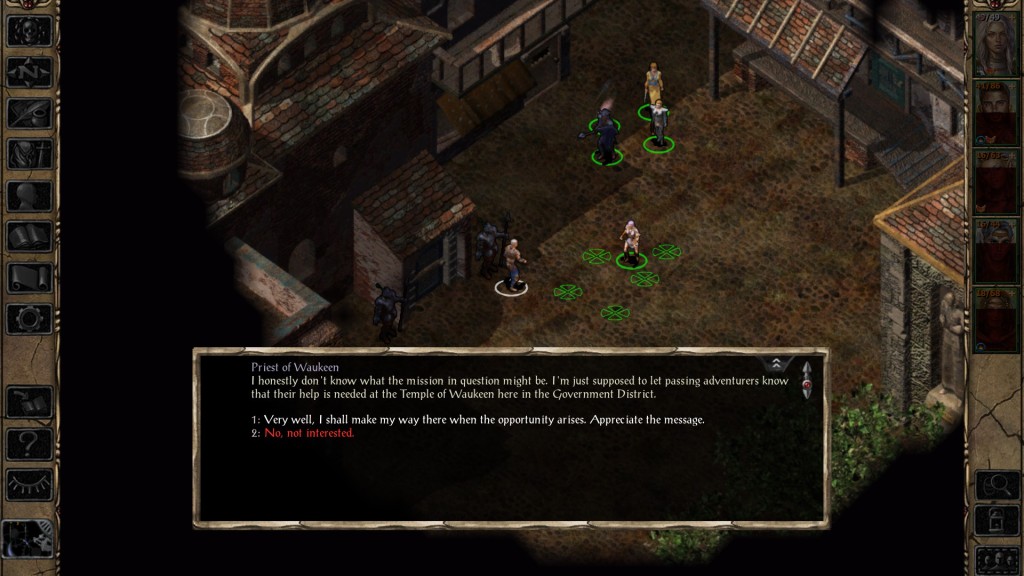
I love that the responses you can give here are decidedly non-urgent.
Choosing to follow up on this request will shortly direct you to the mod’s first new area out of a staggering 46. Each and every one of them is gorgeous and blends in seamlessly with the game around them, and the first area — Goldspires — is a great first impression. Given that Athkatla is the City of Coin, and Waukeen is the goddess of trade, the abbey devoted to her should be fairly grand. Call of the Lost Goddess does not disappoint, and as well as serving as an important area in the mod’s main quest, it also functions as a worthy extension to Athkatla itself. It even comes with its own 3D intro movie, and while it is a little stiff, it’s an excellent touch that feels in line with the era of the game.
To keep this a spoiler-light review, I won’t go into some of the explicit details of the story, but the main premise of the mod serves to sum it up adequately: the leader of the Church of Waukeen hires you to venture into the abyss and rescue Waukeen. It is a decidedly far-fetched idea, and upon finding this out in-game, there are very few companions that aren’t hesitant, at the very least.
The fact that such a monumental task befitting the main quest of an RPG manages to avoid feeling tonally dissonant within the story Baldur’s Gate II is a joy. Interestingly, due to such an important event taking place within a tabletop module itself, the rescue of Waukeen in the lore of the Forgotten Realms was up to “a group of adventurers.” So why not this group of adventurers?
Taking on this challenge sees us venturing into the abyss, to a city named Samora. The city is owned by the demon lord Graz’zt, though an encounter with him would certainly be lethal. Fortunately, the big boss has his attentions diverted elsewhere, so you’ll only be having to blend in with and deal with all the lesser demons hanging around the city. Not too tough, right?
To get there in the first place, though, you have to do a little planes-traveling. The Church of Selune is assisting in this matter, as there exists a method of traveling named the Infinite Staircase, which takes you past the Moonmaiden’s realm (she’s not in at the moment), and through a wonderfully weird staircase surrounded by stars and doors to other planes of existence. You can’t go through them, but their presence is felt via the creatures and interactions you can have on the staircase — besides, almost every character you speak to outright tells you that your destination is the most horrid and dangerous place in the multiverse. Why would you want to go anywhere else?
This is one of my favourite parts of the mod, even if it doesn’t last for too long. It should be at this point that you’ll likely begin to notice some inspiration from Planescape: Torment, and I don’t believe I’ve seen PS:T-inspired content in a mod that is handled as deftly as done here. There are a few tieflings and plane-travelers in Samora that use Sigil slang (or, the Cant), though not in a particularly egregious way that some mods lean towards. Call of the Lost Goddess is a fine blend that makes it feel as though the two games exist in the same universe, which is nice.
There’s a lost modron on the staircase that requires you to complete a puzzle in order to send home. The answer to the puzzle is given to you for free if you have a high enough intelligence score, but I did not, so I had to use my real life intelligence score and write down potential solutions on a piece of paper. It was fun, and I love modrons. Honestly, giving the solution to the player for free with an intelligence check is almost too nice, in my opinion, though perhaps it’s wishful thinking on my part to hope that the mod would go all-in on old-school design.
The staircase has quite a bit of side content to engage with even beyond this, with little unique characters sprinkled throughout, with quests to give and rumours to tell and items to sell. There’s even a little hut in which the Planewalker’s Guild resides. It’s cute, and they offer some basic services, but I wish there was a little more going on in there. The reason I bring it up is because it offers you “rooms” to sleep in, but if you kill all of the inhabitants, the area instead changes into a safe area to camp in. It’s a small detail that I wasn’t expecting, but one that I thought was quite cool.
Entering into Samora once you’re done with the staircase is where things begin to get real. The area is roughly the size of Trademeet, with many more places to travel to besides, but it is here in Samora that the main content of the mod takes place.
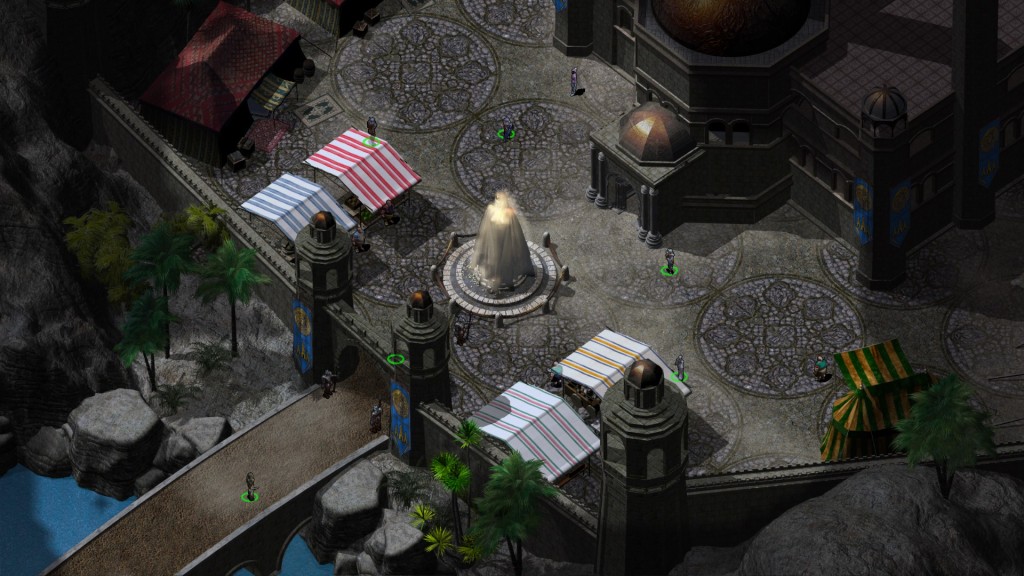
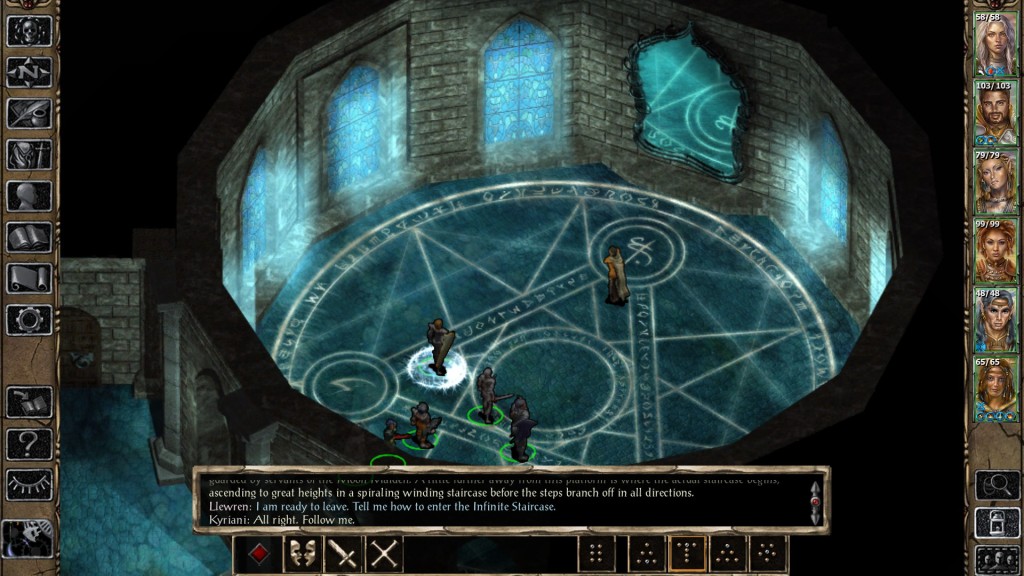
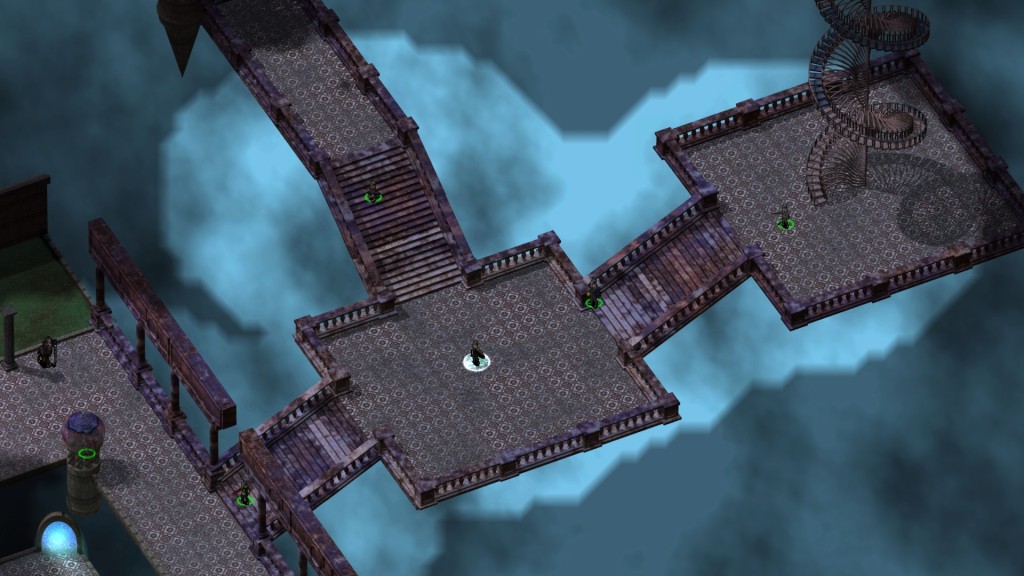
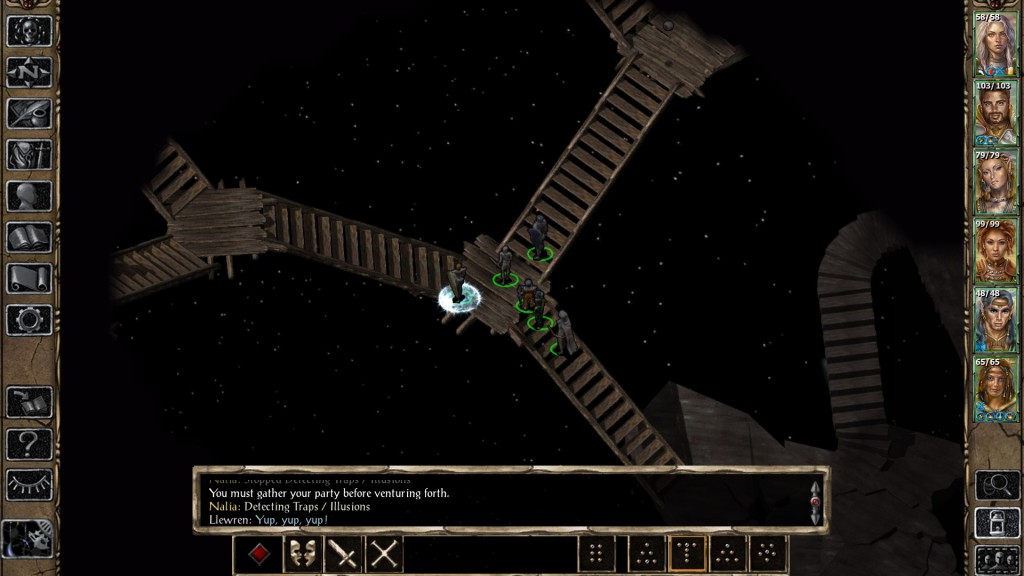
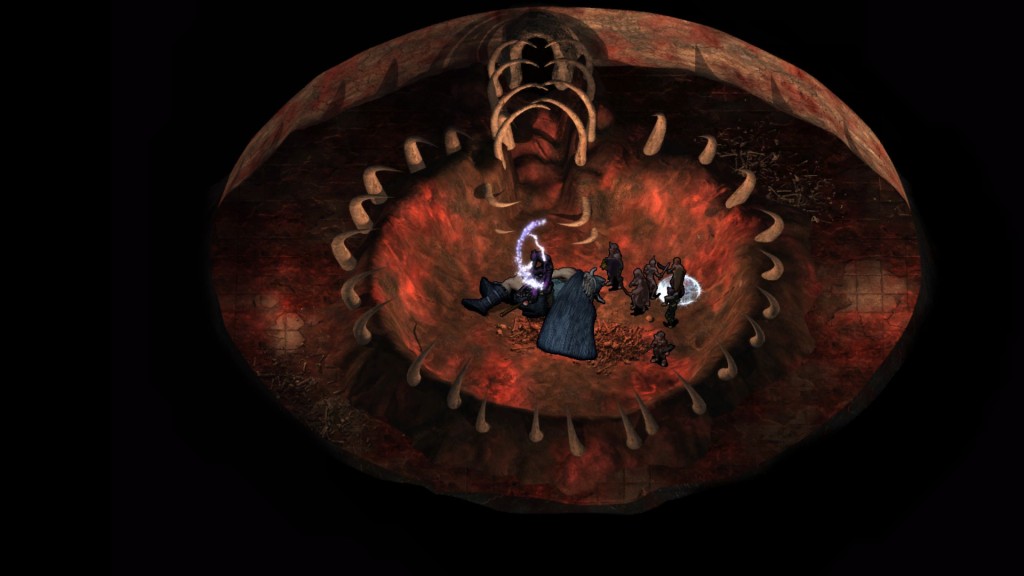
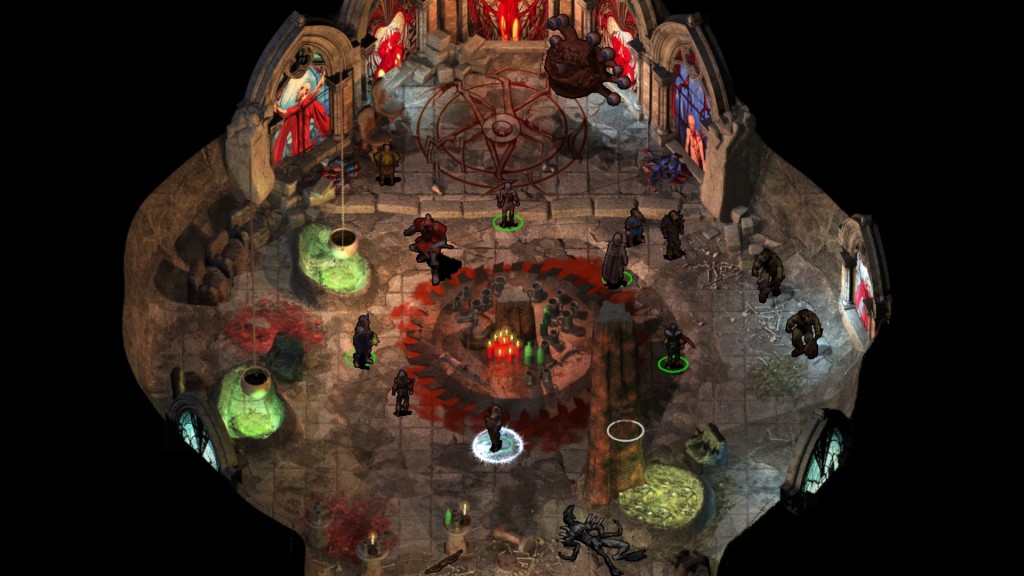
One may expect to find a settlement in the abyss in the throes of chaos, but Call of the Lost Goddess does an excellent job of making Samora feel like a halfway functional society, and the chaos that demons are known for is evident in ways a mite subtler than bloody warfare in the streets. The easiest way to blend in is to simply pretend that you’re there for bloodshed and pillaging, and such a truth will earn you respect, so long as you respect the rule of Graz’zt, and by extension, his underlings who currently reside over the city.
Infiltrating your way closer to the “inner circle” so that you may fulfill your mission will have you dealing with a lot. There are multiple quests associated with this task, each taking you to new abyssal locations and interacting (and often killing) new creatures. Several of these quests offer you some interesting alternatives — creating alliances and striking deals, and I was pleasantly surprised to see more content open up as a direct result of this. There is very often multiple ways to do things. In fact, going in guns blazing and immediately slaughtering every demon in sight ala Doom is a perfectly valid way to complete this entire quest, albeit a difficult one, and one that does reap fewer rewards — I think it would have been nice to have an extra reward for doing this, so that this optional path isn’t indirectly punished.
Besides the main storyline, there are several more side quests and subplots within Samora and the surrounding locales, with some including moral choices and alternative outcomes depending on your actions. It goes a long way to make the abyss feel like a living, breathing place filled with evil creatures. No matter who you help in this place, there’s a good chance that they’re also an evil bastard, and they don’t hide that fact. The temptation to simply kill everyone is strong indeed, but this is a level 10+ adventure.
In fact, with a full party, I completed every new quest introduced by the mod and didn’t get enough experience points to level up from 10 to 11 until the very end. While there’s a lot of very powerful equipment, the mod is very careful with how it rewards experience, which is something I can greatly appreciate.
Call of the Lost Goddess, as a whole, is a completely awe-inspiring piece of work filled with genuinely good game design, writing, and visuals, but it isn’t quite perfect… yet. Thankfully, the issues that I have with the mod are minor at best and may come down to personal preference, and it’s early days yet in regards to future updates.
First off, the mod optionally comes with AI-generated voices and portraits for major characters. My thoughts on the matter haven’t particularly changed since the review of Crucible, another mod that uses AI voices, except in this case they sound — dare I say — even worse. It’s odd, too, because Crucible is fully voiced, and Call of the Lost Goddess only intermittently uses voices, yet they feel borderline unlistenable to my ears. The only good voice, in my opinion, was that of the Modron. I’m not trying to be funny, but the computer did a good job at voicing the robot. Let’s get a “modron only” version petition going, eh?
Many characters have one to three voiced lines they’ll spout when clicked on, and I thought this wouldn’t be too bad, but in Samora there are facsimiles of lines that generic characters say in Faerun. Take, for instance, “My prices are the best south of Waterdeep!” Those familiar enough with the games will know right away what that sounds like. Now, imagine a computer soullessly reading aloud “My prices are the best prices south of Hell.” It would be funny if it was read with a shred of personality and if it were a one-off joke, but it keeps going. “An army marches on its mortals,” “My tavern is as dirty as a devil’s ass,” etc. It’s just sad hearing these lines, so previously filled with human delivery, parodied like a cheap knockoff. I don’t feel bad saying that the voices are awful, because there is an utterly minimal amount of human effort behind them by the technology’s nature.
Thankfully the voices are optional, and you can dip into the sound files of the mod before downloading to see what you think.
The portraits fair a little better, though I have an intrinsic distaste for the style of most AI art and I am unsure what qualifies as an important character. I feel as though the only characters that would warrant portraits are Holycoin Tharundar, Maretta, and Waukeen herself. Unfortunately, the latter two suffer from AI jank. If it were just those three, I’d love to see actual artists given a shot at rendering their likeness. Though I understand the obstacles in doing so.
Again, these are optional, and I find my enjoyment of the mod better without the sporadic portraits.
The writing, while good from a creative and grammatical standpoint, suffers from poor pacing within individual paragraphs. Often I was bombarded with large walls of text that contain information that was worth reading, but I found it hard to simply because it wasn’t broken up enough. Honestly, the entire mod could do with a do-over with a few additional paraphrases and breaks in text. There is also a distracting number of times that the player is referred to as their race, which you would think would make sense considering the setting, but it still feels odd. Sometimes the mod defaults to referring to the player character as “he” as well.
The mod consistently places a space before any ellipses and while the new item descriptions match the style of the rest of the series, there’s a distinct lack of em dashes in place of en dashes despite the use of special characters throughout the mod. I refuse to ever stop mentioning em dashes in my reviews. I’m not sorry.
Item, character, and location names also often suffer from confused capitalisation, e.g. e.g. “Agony fire Forge,” “Book of fiends,” “Manual of the tough fool,” “Badge against the evil eye.” Words like “drow” are sometimes capitalised when they don’t need to be either.
I also wasn’t a huge fan of the liberal use of descriptive parentheticals the mod utilises. While those dreaded words carry a certain stigma here at the Smoldering Mods Bar, I actually didn’t mind it that much. The writing is solid, but it often feels like the information being given via descriptions could very easily have been garnered from the conversation itself, especially considering the strength of the character writing on display. The descriptions also suffer from a case of verboseness, and I believe that most if not all of them could be cut down, and some of them cut completely.
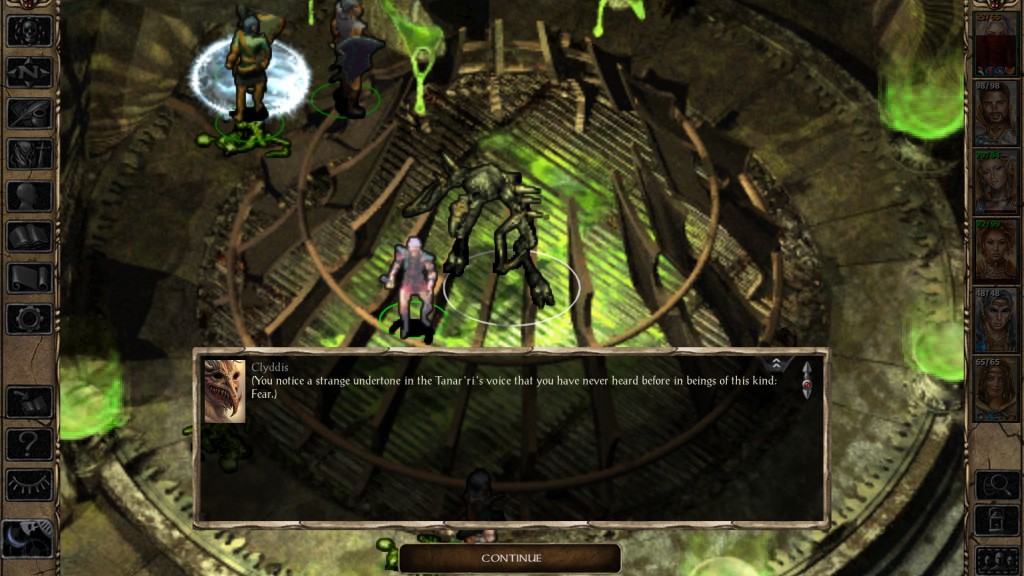
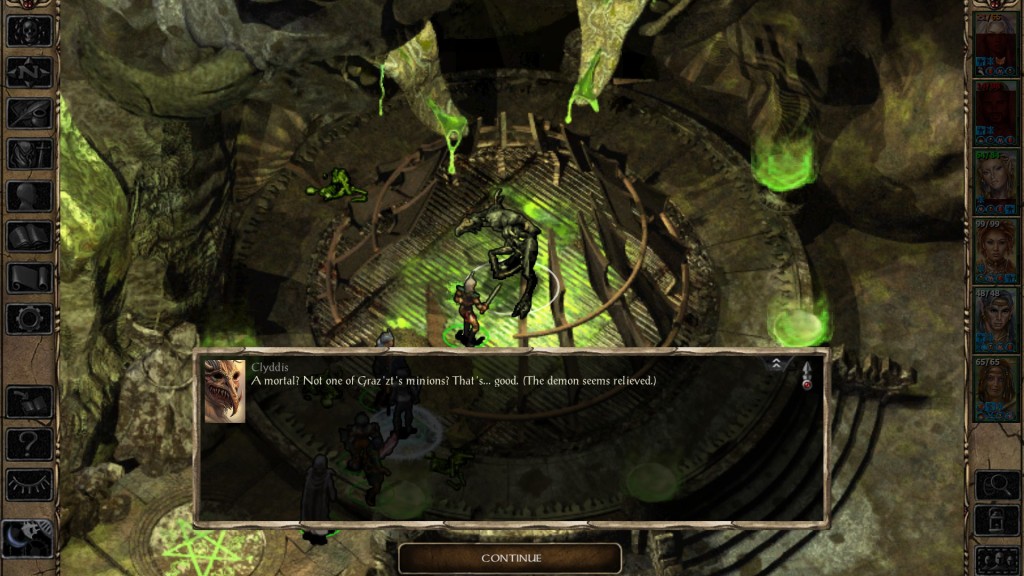
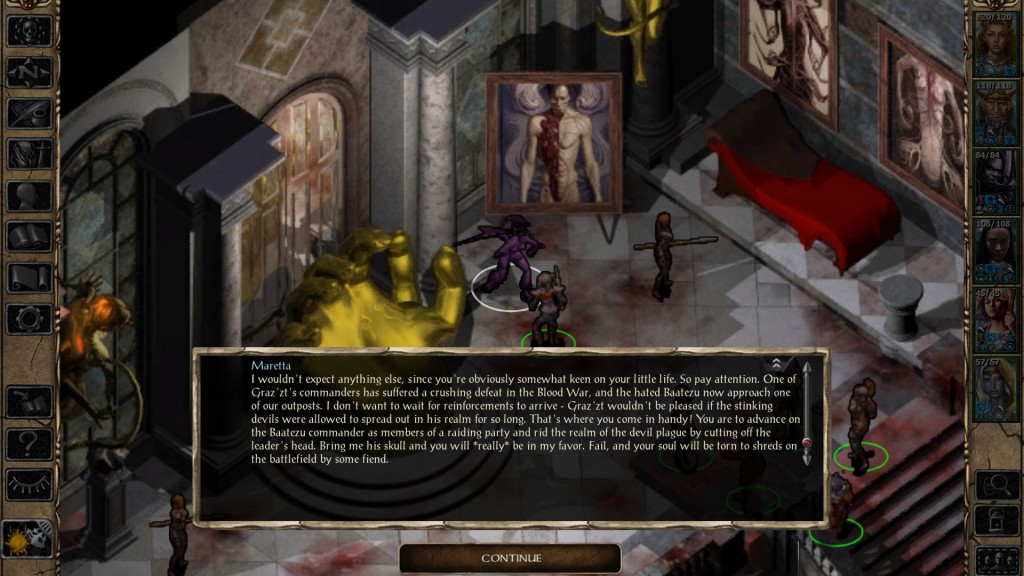
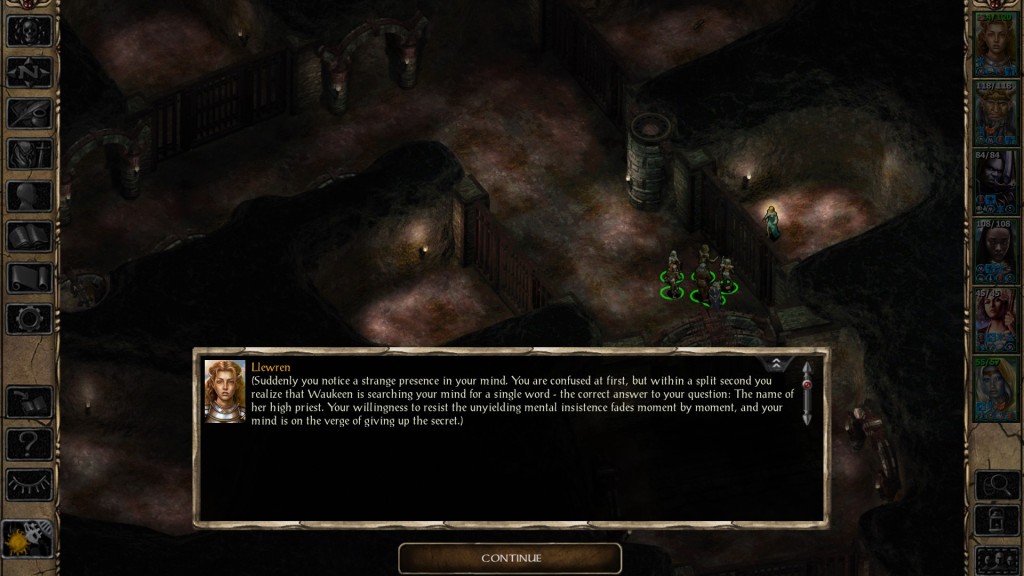
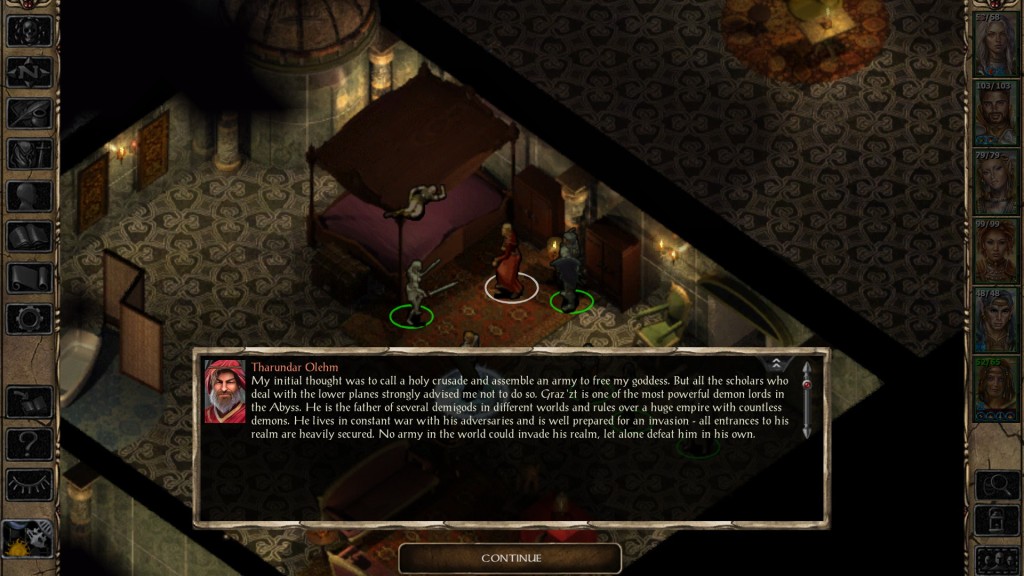
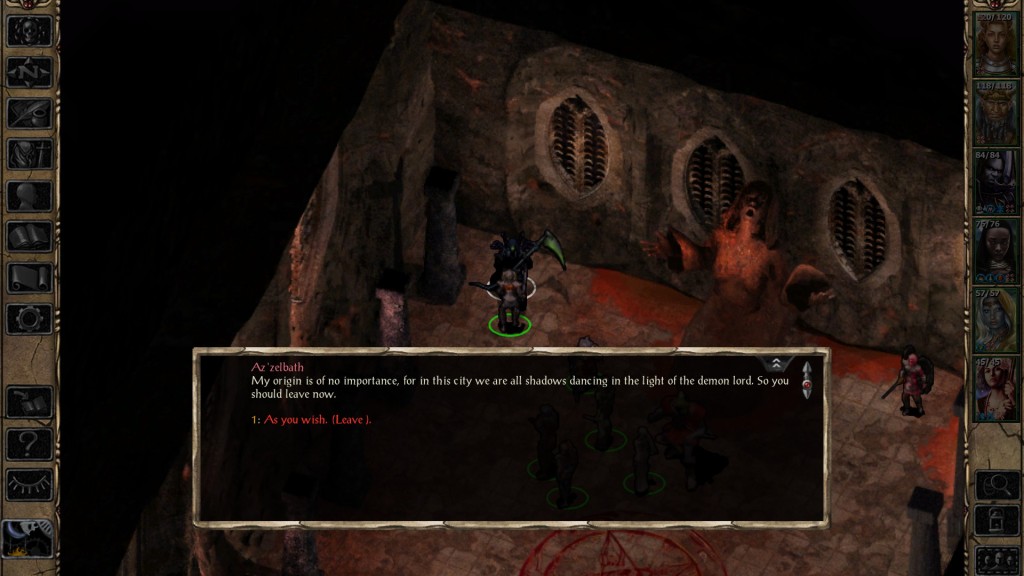
There are also many occasions where to leave the conversation or to attack instantly, the mod specifies (leave) and (attack), which I found consistently distracting. I’m not sure what the specified action has over a simple “Farewell” or “Meet my steel, brigand!” but I digress. I am a nitpicker and a pedant, so take my words with a grain of salt.
I point out this collection of small perceived flaws because I don’t want to simply brush them under the rug when bringing attention to them may result in a better final product — and despite all of this, Call of the Lost Goddess is absolutely one of the highest quality mods out there.
There may be more content that comes out for this mod in the future, and it definitely feels as though the events that take place would affect the world at large in some way and put a target on the player’s back. It would be great to see some reasons to return to Goldspires in the future as well.
I’ve held off on talking about one of my favourite things about Call of the Lost Goddess in depth. It’s the items — the tangible rewards that you’ll take with you into the rest of the game. In total, there’s over forty, and I truly don’t feel as though they affect the “balance” of the game in any unruly way. They make for a fun and interesting time, and I love mods that introduce fun new items because I can’t stand using the same “best” equipment on every playthrough.
The new items introduced by Call of the Lost Goddess all offer something that isn’t necessarily more powerful than what you’d find elsewhere, but give the player creative alternatives to items that may be getting a little stale by now.
Doing everything available to you will leave you the richest you’ve likely ever been in Baldur’s Gate, but I don’t think that’s such a bad thing, especially since the experience reward itself isn’t actually that substantial.
Beyond the minor nitpicks I have, I genuinely think that Call of the Lost Goddess is one of the most impressive mods ever made by this community, and I highly encourage anyone and everyone to give it a try if anything in this review caught your attention. It’s worth your time. I for one likely won’t be playing Baldur’s Gate II without it for the foreseeable future. It’s just that good.
Thanks for rreading.


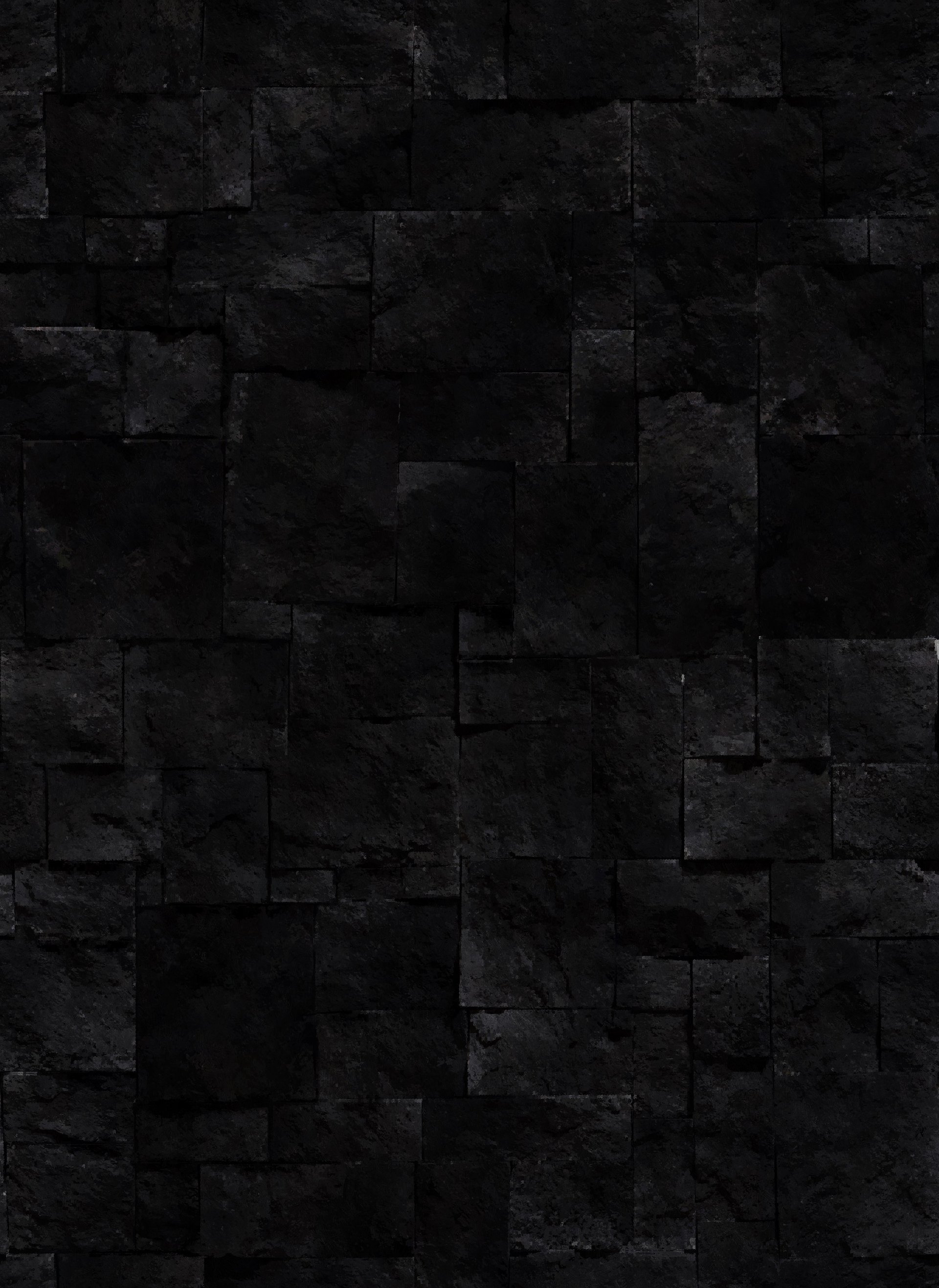
Leave a comment